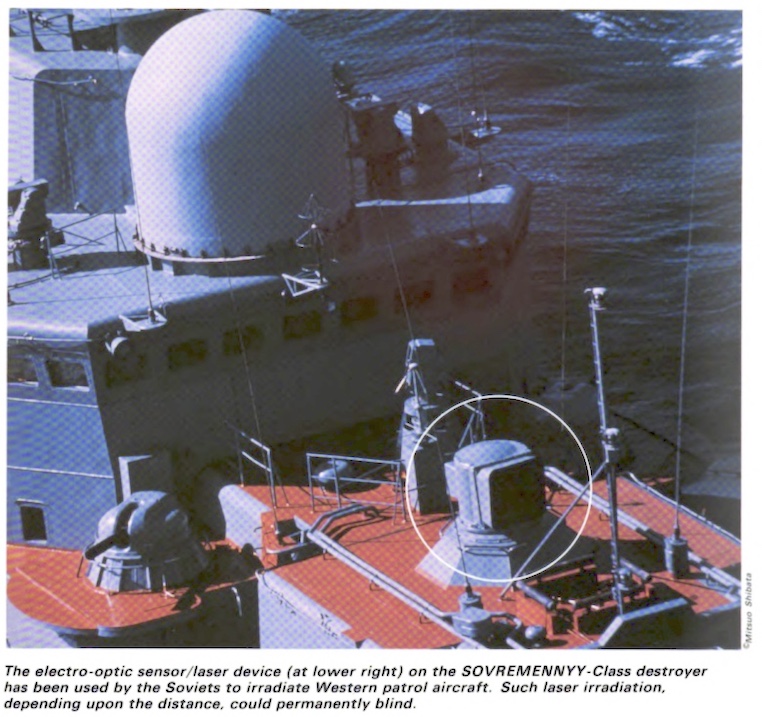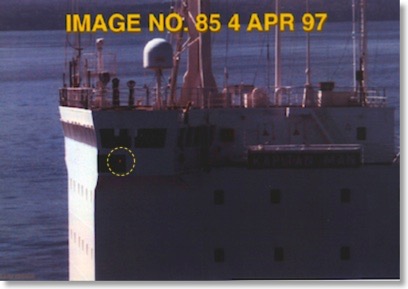Home
A comprehensive resource for safe and responsible laser use
US: Military says Soviet ship aimed laser at US aircraft; injuring pilot's eyes
The incident happened September 30 or October 1, 1987. According to an October 2 1987 Pentagon statement, a U.S. Navy P-3 reconnaissance aircraft was “illuminated by an intense light” from the Soviet ship Chukotka. An Air Force WC-135 intelligence plane also was illuminated.
The statement said the light “disturbed” the vision of the co-pilot, and “although preliminary medical evaluation has shown no apparent damage, further detailed tests may be required to determine if, in fact, no damage to her eyes occurred.”
Sen. Malcolm Wallop (R-Wy) initially disclosed the incident. He said “In my opinion, anything that disturbs your vision for 10 minutes damages your vision. The effect was to temporarily blind that co-pilot."
According to the Pentagon, they believe the light source was a laser. The Pentagon statement did not speculate on the reason for the illumination of the aircraft.
The New York Times referenced one official who said the Soviet ship might have tried to harass or blind the pilots, while a naval consultant said it could be that the laser was used to track missiles and was inadvertently shined at the U.S. aircraft.
Such illumination had occurred before, according to the Pentagon statement.
The 1987 edition of a Pentagon publication, Soviet Military Power, said that "recent Soviet irradiation of Free World manned surveillance aircraft and ships could have caused serious eye damage to observers." The following picture and caption appeared on page 113 in the book:

From the New York Times and the Los Angeles Times
US and Iran: UPDATED - Iranian naval ship shines laser on US helicopter says U.S.; Iran denies
A group of three U.S. ships — a destroyer, an amphibious assault ship, and a dry cargo ship — were transiting international waters in the Strait of Hormuz, according to a U.S. military statement. The Iranian naval vessel, said by one source to be a missile ship, came within 800 yards of the assault ship and scanned two of the U.S. ships with a spotlight.
The helicopter was flying alongside the deployment when the Iranian targeting laser was aimed at it, setting off the flares.
There was no report of injury to the helicopter pilots. A spokesperson for the U.S. Navy’s Fifth Fleet said “Illuminating helicopters with lasers at night is dangerous as it creates a navigational hazard that can impair vision and can be disorienting to pilots using night vision goggles.”

Marine Corps Sikorsky CH-53E Super Stallion
From Newsweek and CNN
UPDATED JULY 16 2017 - Iran claimed it did not point a laser at the helicopter. The Tasnim News Agency said “A top commander of Iran’s Navy denied reports that the country’s naval forces had pointed a laser at an airborne US Marine Corps helicopter in the Strait of Hormuz back in June. Commander of Iran's First Naval Zone Admiral Hossein Azad categorically denied reports of such incident.”
The report had no additional details, such as what could have set off the helicopter’s flares as claimed by the initial U.S. report.
From the Tasnim News Agency and the Tehran Times
Iran: U.S. ship and helicopter targeted by laser on Iranian merchant ship
There were no reports of injuries or damage caused by the laser, so the Navy “believes it was not of industrial or military grade quality….” A Navy public affairs officer from the U.S. Naval Forces Central Command called the Iranian use of the laser as “unsafe” and “unprofessional.”
From CNN and Stars and Stripes. Thanks to Greg Makhov for bringing this to our attention. Note: The U.S. Navy in November 2014 deployed the first laser weapon sent into trials on an active duty warship, the USS Ponce. Six commercial welding lasers are merged into a single beam of 30 kilowatts, that can be used against targets including Iranian gunboats, according to SlashGear.
US: DOD confirms eye injury to copter passenger; perhaps from Russian vessel Kapitan Man?
Coast Guard and Navy personnel boarded the vessel on April 7 but were unable to find any laser device, or evidence of a possible device. U.S. Navy Lt. Cmdr. Jack Daly was then examined by military laser eye injury experts, who found “there was a high probability that the minor burns on the lieutenant's right retina were caused by multiple laser exposures such as might result from a single glimpse at a repetitive pulsed laser.”

The American naval officer took this photo in the Strait of Juan de Fuca showing a red light on the M/V Kapitan Man. The light led some to suspect a laser. However, subsequent inspection did not find a laser, and in the location of the red light were “two deep red running lights … that met the guidelines established for sidelights.”
The U.S. Defense Department concluded that “[a]vailable evidence does not indicate…what the source of such an exposure might have been. Specifically, there is no physical evidence tying the eye injury of the American officer to a laser located on the Russian merchant vessel.”
The Strait of Juan de Fuca laser incident was also discussed in the August 2004 medical journal Archives of Ophthalmology. The article “Assessment of Alleged Retinal Laser Injuries” describes “Case 5” and concludes that “…[n]o evidence of laser injury was found in the years after the incident by 17 other ophthalmologists, including 5 neuro-ophthalmalogists and 8 retina specialists. A trial was held 5 years after the incident in which the retina specialist who made the initial diagnosis steadfastly maintained all the photographer’s [naval officer’s] symptoms were due to retinal laser injury. A jury ruled against the photographer’s claim for damages against the ship’s owner.… The patient had real complaints, but they were caused by preexisting autoimmune problems rather than by laser injury.”
The full text of the DOD press release, and the “Case 5” study is below (click the “Read More…” link). Additional information above is from a 2011 Washington Times story.